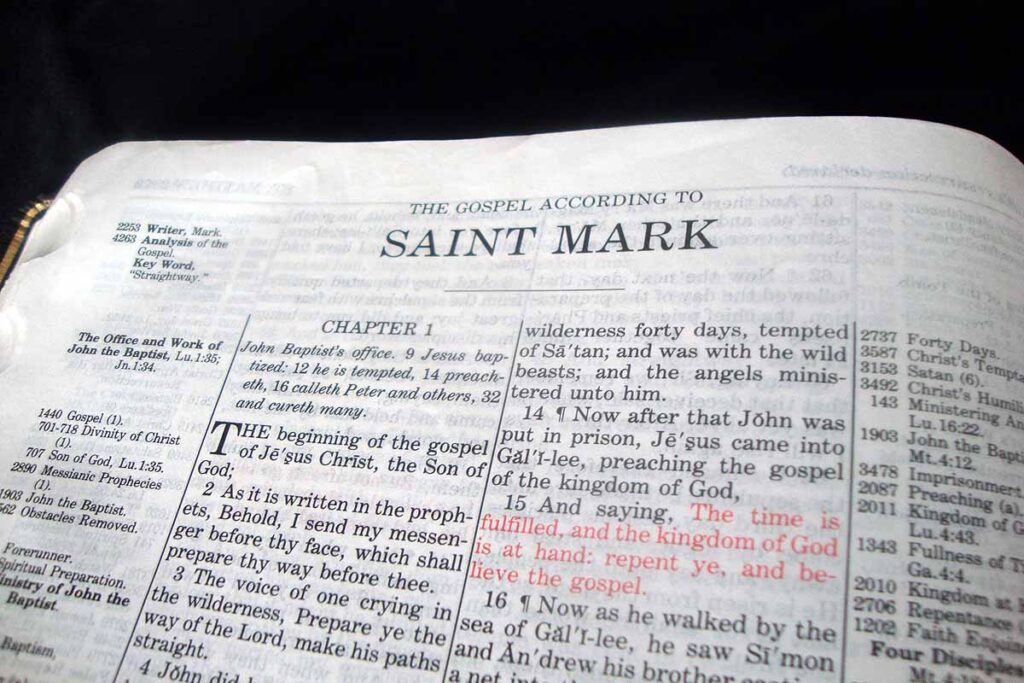Though Mark wrote from Rome, the gospel of Mark was composed for the wider church as the record of the apostolic testimony of Peter. Even during the early Patristic period, Gentile Christians were frequently mentioned as the recipients of this Gospel. Mark addresses an audience that is largely unfamiliar with Jewish customs. He intends to familiarize them with those customs, because only then will they understand the coming of Jesus as the culmination of God’s work with Israel and the entire world.
Jesus did not arrive unannounced or unexpected. The Old Testament prophets had clearly predicted the coming of a Great One, sent by God himself, who would offer salvation and eternal peace to Israel and the entire world. Then came John the Baptist, who announced that the long-awaited Messiah had finally come and would soon be among the people. In God’s work in the world today, Jesus does not come unannounced or unexpected. Yet many still reject him. We have the witness of the Bible, but some choose to ignore it, just as many ignored John the Baptist in his day.
Jesus had all power of almighty God – he raised the dead, gave sight to the blind, restored deformed bodies, and quieted stormy seas. But with all this power, Jesus came to mankind as a servant. We can use his life as a pattern for how to live today. As Jesus served God and others so should we.
Jesus came as a servant, so many did not recognize or acknowledge him as the Messiah. We, too, must be careful we don’t reject God or his will because he doesn’t quite fit our image of what God should be.
Writer of the Gospel of Mark
John Mark. He was not one of the 12 disciples but he accompanied Paul on his first missionary journey (Acts 13:13).
The gospel of Mark nowhere mentions the name of its author. Tradition unanimously ascribes this gospel to John Mark a native of Jerusalem (Acts 12:12), and later an associate of both Peter (1 Peter 5:13) and Paul (2 Timothy 4:11). If Mark composed his gospel while in the services of Peter, and Peter died in Rome between A.D. 64 and A.D. 68, then the gospel would have been written in Italy in the late ’60s.
Date Written
During the two years that Paul was in his own hired house in Rome (A. D. 61-63), continuing to preach the kingdom of God (Acts 28:31). Mark wrote the gospel of Mark at about the same time as Paul wrote Colossians. Written from an unspecified location.
To Whom Written
The Christians in Rome, where he wrote the book. The explanation of Jewish words and customs would indicate that the author has foreigners in mind when he wrote. See ch. 3:17; 5:41; 7:1-4, 11, 34.
Mark spoke of “the prophets,” a reference meaningful only to Jews (Mark 1:2). It was the Jews who had difficulty in seeing the suffering servant aspect of the Messiah, looking only for His kingly role. Since Israel was then subjugated to Rome, it was meaningful that the Lord Jesus Christ had willfully taken the position of a servant, coming to earth as a Jew. It was also noteworthy that this book recorded the emotions of Christ, reserving the use of the term “Lord” in reference to Him until the final chapter.
Some, including Charles Welch, have suggested that the direct, to-the-point style of writing in Mark indicated a specific appeal to the practical roman mindset (with its emphasis on such empire-building endeavors as the construction of roads and aqueducts), in contrast to the intellectual but impractical Greek mindset. Thus, the succinct style of the book would have appealed to ancestral Jews living in Rome at the time. It has long been thought that Mark’s source for his gospel was Peter, who also would have appreciated brevity. This book may have been written from Babylon, while Mark was there with Peter (I Peter 5:13).
Purpose of the Gospel of Mark
The purpose of the gospel of Mark was to present the Lord Jesus Christ as God’s servant.
As such, a record of His humiliation and suffering was set forth, rather than His lineage. Before He would be Israel’s king in His second advent, He would be God’s suffering servant (the ultimate sacrifice for sin) in His first advent.
The mission statement of the Gospel of Mark (if not the statement of purpose of the Acts period) was given in Mark 16:15-20.
And he said unto them [the disciples], Go ye into all the world, and preach the gospel to every creature. He that believeth and is baptized shall be saved, but he that believeth not shall be damned. And these signs shall follow them that believe; In my name shall they cast out devils; they shall speak in new tongues; They shall take up serpents; and if they drink any deadly thing, it shall not hurt them; they shall lay hands on the sick, and they shall recover. So then after the Lord had spoken to them, he was received up into heaven and sat on the right hand of God. And they went forth, and preached everywhere, the Lord working with them, and confirming the word with signs following. Amen
Theological Contribution
One of Mark’s key objectives is to portray Jesus as God’s Son. At decisive points in this story, he reveals the mystery of Jesus’ person. At the baptism and Transfiguration, the Father in heaven calls Jesus “My beloved Son,” thus indicating that Jesus shares a unique relationship with the Father. Demons recognize Jesus as God’s Son, too, testifying that Jesus is equipped with God’s authority and power.
However, Jesus is powerful according to the model of the Suffering Servant of Isaiah. He must be obedient to the will of the father, even to death on a cross. He is human, for He appears sorrowful, disappointed, displeased, angry, amazed, and fatigued.
For Mark, faith and discipleship have no meaning apart from following the suffering Son of God. Faith is not a magic that works independently of the believer’s participation; rather, it draws the belief into intimate union with Jesus as Lord. AS the Son of Man serves in self-abasement, so too must His disciples serve. Discipleship with Christ leads to self-denial and suffering. This, however, is not a matter of religious desire to suffer; rather, when one loses his life, he finds it in Christ.
Special Consideration in the Gospel of Mark
The ending of the gospel of Mark poses a problem. The two oldest and most important manuscripts of the Greek New Testament (Sinaiticus and Vaticanus) end with the words, “For they were afraid”. Other manuscripts add, in whole or in part, the material making up verses 9-20. This longer ending, however, is unlike Mark 1:1 – 16:8 in style and content; it contains material presented exactly as it is in Matthew and Luke. It has long been debated whether Mark intended to end his gospel at 16:8, or whether the original ending was lost and a secondary ending (vv. 9-20) was later added.
It seems unlikely that having begun the gospel with a bold introduction, Mark would end it on a note of fear. It would also seem logical that one who drafted a gospel along the lines of the early Christian preaching would not have omitted a central feature like the resurrection (1 Cor. 15:3-26). These reasons suggest that the shorter ending of Mark (at 16:8) is not the original (or intended) ending – for whatever reason – and that verses 9-20 are a later addition supplied to compensate for the omission.
Recommended Bible Study Resources
ESV Study Bible – Study Bibles give you a deeper understanding of God’s Word with tools for life application like commentary, maps, charts, concordance, and study notes. Search our popular translations- NIV, ESV, NKJV, KJV and more!
Believer’s Bible Commentary: Second Edition – A Bible commentary is a written, systematic series of explanations and interpretations of Scripture. Commentaries often analyze or expound on individual books of the Bible, chapter by chapter and verse by verse. Some commentary works provide analysis of the whole of Scripture.
The New Strong’s Expanded Exhaustive Concordance of the Bible – The best concordance for word study! This exclusive new edition of a legendary classic puts generations of biblical research at your fingertips. A valuable tool for pastors, teachers, and students of the Bible.
Vine’s Complete Expository Dictionary of Old and New Testament Words – This classic word study resource allows you to study the meaning of biblical words in the original languages without spending years learning Greek or Hebrew. A great resource for students, seasoned pastors, and anyone who enjoys biblical word studies–even if they have little to no formal training in Hebrew or Greek.
Halley’s Bible Handbook – The beloved and classic Bible companion has been thoroughly updated, while retaining its time-honored features and Dr. Halley’s highly personal style, to offer even greater clarity, insight, and usefulness.
Click here to print or download the Bible outline on the “Gospel of Mark“








